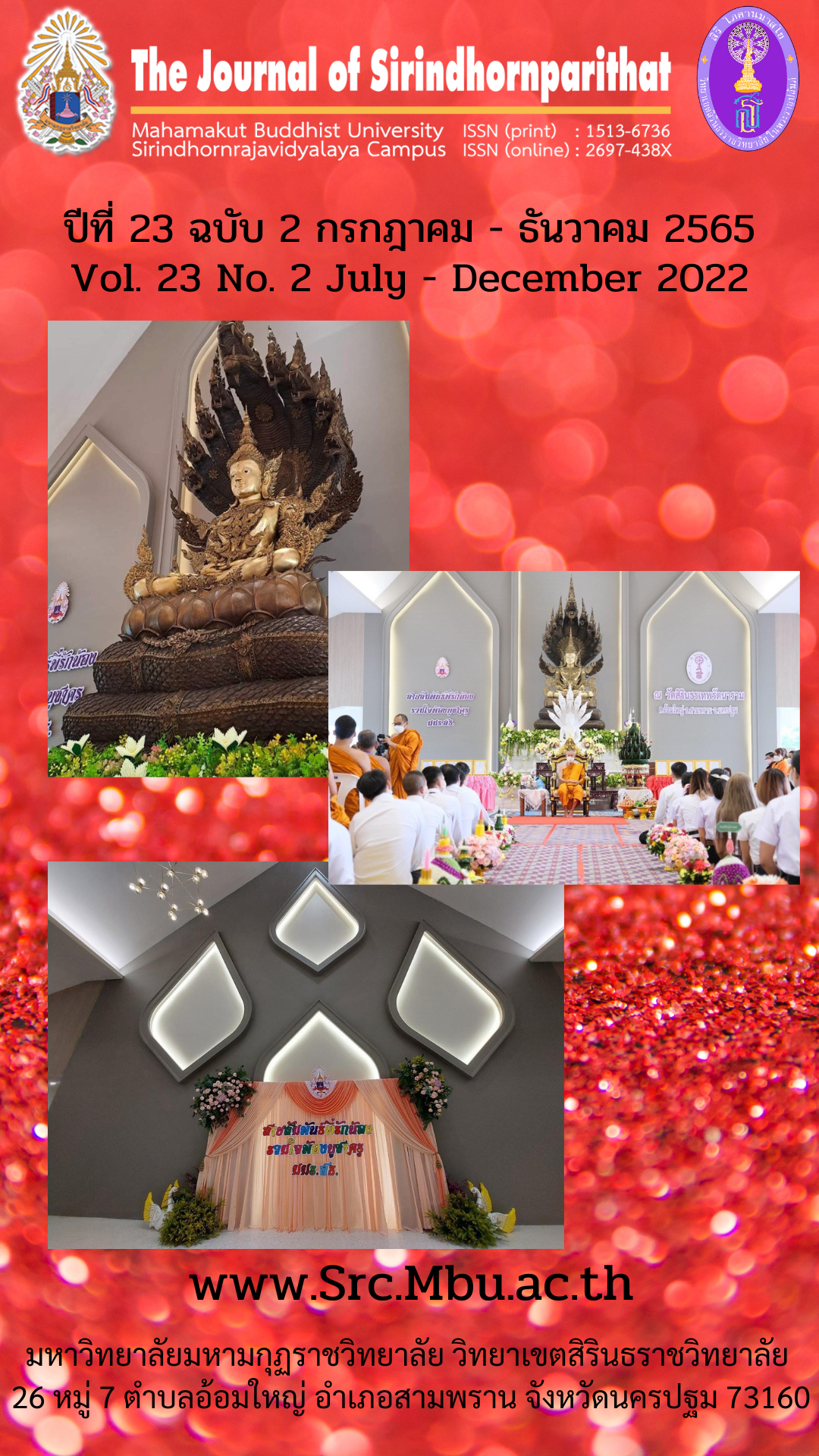Influence of Sound Designer’S Disposition, Temperament, and Quality of Life on Film Sound Art in Shanxi, China
Keywords:
Film Sound Art, Sound Designer, Personality, Quality of LifeAbstract
This studies the influence of the psychological status and quality of life of film sound designers on the sound of films. On the basis of the literature review, three independent variables such as character, temperament, and quality of life of film sound designers were selected and hypotheses were put forward. On this basis, the development of the questionnaire. The sample was taken from 425 film sound designers currently working on film sound creation in China. In the process of research, these influencing factors are firstly quantified and coded, and correlation analysis is conducted on this basis. Then, by means of regression, the influence factors and the significance of sound art creation of films are verified in an empirical way.
จากการวิจัยพบว่าอารมณ์ คุณภาพชีวิต และเสียงของนักออกแบบเสียงภาพยนตร์มีความสำคัญ แต่บุคลิกภาพของนักออกแบบเสียงนั้นไม่ใช่ จากผลการวิจัย ในที่สุดบทความนี้เสนอข้อเสนอแนะต่อไปนี้: ในการคัดเลือกและกำหนดตำแหน่งงานของนักออกแบบเสียงภาพยนตร์ ควรพิจารณาลักษณะทางจิตวิทยาของผู้คนรวมถึงข้อกำหนดวัตถุประสงค์ของงานด้วย นอกจากนี้ ในการศึกษาบทความนี้ ฉันพบปัญหาที่การศึกษาก่อนหน้านี้ไม่ได้ให้ความสนใจ: จำเป็นต้องศึกษาเพิ่มเติมเกี่ยวกับการออกแบบเสียงของภาพยนตร์ในสภาพแวดล้อมทั่วไปของการผลิตภาพยนตร์ โดยเฉพาะอย่างยิ่งเพื่อศึกษาอย่างละเอียดเกี่ยวกับไมโครและ ปัจจัยที่มีอิทธิพลต่อมหภาค จำเป็นต้องศึกษาการออกแบบเสียงของภาพยนตร์เนื่องจากความแตกต่างที่เกิดจากความแตกต่างส่วนบุคคลของนักออกแบบเสียงภาพยนตร์ นอกจากนี้ยังจำเป็นต้องศึกษาความแตกต่างของการออกแบบเสียงภาพยนตร์ที่เกิดจากการเปลี่ยนแปลงของเศรษฐกิจ สังคม นโยบายภาพยนตร์ และภูมิหลังทางวัฒนธรรม ผ่านการวิเคราะห์อย่างเป็นระบบหลายระดับ หลายมุม เผยให้เห็นกฎทั่วไปของการออกแบบเสียงภาพยนตร์ จะเป็นแนวทางในการศึกษาต่อไป
References
Andrew J. Elliot, Carol S. Dweck & David S. Yeager. (2017). Handbook of Competence and Motivation, Second Edition: Theory and Application. New York: Guilford Press.
Armstrong, J. S. (2012). Predicting job performance: The moneyball factor. Foresight: The International Journal of Applied Forecasting, 25, 31-34.
Arnheim, R. (1957). Film as Art: 50th Anniversary Printing. Univ of California Press.
Ash, M. G. (2002). Cultural contexts and scientific change in psychology: Kurt Lewin in Iowa. American Psychological Association.
Barnard, C. I. (1938). The Functions of the Executive (Cambridge, Mass.: Har¬ vard University Press). BarnardThe Functions of the Executive1938.
Brownlow, K. (1968). The parade's gone by. Univ of California Press.
Bottomley, A. (2002). The cancer patient and quality of life. The Oncologist, 7(2), 120-125.
Chess, S., & Thomas, A. (2013). Temperament: Theory and practice. Routledge.
Costanza, R., Fisher, B., Ali, S., Beer, C., Bond, L., Boumans, R., Danigelis, N.L., Dickinson, J., Elliott, C., Farley, J. & Gayer, D.E. (2008). An integrative approach to quality of life measurement, research, and policy. SAPI EN. S. Surveys and Perspectives Integrating
Environment and Society, 26(1.1).
D. W. Ekstrand. (2012). The Four Human Temperaments. Retrieved from http://www. thetransformedsoul.com/additional-studies/miscellaneous-studies/the-four-human-temperaments.
David Hume. (1748). An Inquiry Concerning Human Understanding. Oxford: ClarendonPress.
Depue, R. A., & Fu, Y. (2012). Neurobiology and neurochemistry of temperament in adults. Handbook of temperament, 368-399.
Eisenstein, S. (1928). The Unexpected. Film Form.
Fayol, H. (1916). Administration industrielle et générale; prévoyance, organisation, commandement, coordination, controle, Paris, H. Dunod et E. Pinat. Режим доступу: http://www. worldcat. org.
Gnassounou, B. (2016). Dispositions and causal powers. Routledge.
Gregory Derek, Johnston Ron, Pratt Geraldine, Watts Michael, Sarah Whatmore. (2009). Dictionary of Human Geography (5th ed.). Oxford: Wiley-Blackwell.
Guha, M. (2010). Encyclopedia of the Life Course and Human Development. Reference Reviews, 24(2), 16-18.
Hofstede, G., Hofstede, G. J., & Minkov, M. (2005). Cultures and organizations: Software of the mind (Vol. 2). New York: Mcgraw-hill.
IESE Insight. (2013). Quality of Life: Everyone Wants It, But What Is It? Retrieved from https://www.forbes.com/sites/iese/2013/09/04/quality-of-life-everyone-wants-it-but-what-is-it/#5e067cb1635d.
Jerald Greenberg & Robert A. Baron. (2008). Behavior In Organizations (9th Edition). Prentice Hall.
Kagan, J. (2018). Galen's prophecy: Temperament in human nature. New York: Routledge.
Kail R. V. & Barnfield A. (2011). Children and Their Development, Second Canadian Edition with MyDevelopmentLab. Toronto: Pearson Education Canada.
Katz, D., & Kahn, R. L. (1978). The social psychology of organizations (Vol. 2, p. 528). New York: Wiley.
Lin Dakun. (2005). Psychology of Film and Television Recording. Beijing: China Radio and Television Press.
Magee, L., Scerri, A., & James, P. (2012). Measuring social sustainability: A community-centred approach. Applied Research in Quality of Life, 7(3), 239-261.
Münsterberg, H. (1916). The photoplay: A psychological study. D. Appleton.
Nicholas Culpeper. (1653). An Astrologo-Physical Discourse of the Human Virtues in the Body of Man, transcribed and annotated by Deborah Houlding. Skyscript, 2009 (retrieved 16 November 2011). Originally published in Culpeper's Complete Herbal (English Physician). London: Peter Cole, 1652.
Nussbaum, M., & Sen, A. (Eds.). (1993). The quality of life. Oxford University Press.
O'Reilly, C. A., & Pfeffer, J. (2000). Hidden value: How great companies achieve extraordinary results with ordinary people. Harvard Business Press.
Podsakoff, N. P., Whiting, S. W., Podsakoff, P. M., & Mishra, P. (2011). Effects of organizational citizenship behaviors on selection decisions in employment interviews. Journal of applied psychology, 96(2), 310.
Shimamura, A. P. (Ed.). (2013). Psychocinematics: Exploring cognition at the movies. Oxford University Press.
Xu Nanming, Fu Lan & Cui Junyan. (2005). Dictionary of Film Art. Beijing: China film press.

Downloads
Published
Issue
Section
License
Copyright (c) 2022 Mahamakut Buddhist University

This work is licensed under a Creative Commons Attribution-NonCommercial-NoDerivatives 4.0 International License.
บทความที่ได้รับการตีพิมพ์เป็นลิขสิทธิ์ของ มหาวิทยาลัยมหามกุฏราชวิทยาลัย วิทยาเขตสิรินธรราชวิทยาลัย
ข้อความที่ปรากฏในบทความแต่ละเรื่องในวารสารวิชาการเล่มนี้เป็นความคิดเห็นส่วนตัวของผู้เขียนแต่ละท่านไม่เกี่ยวข้องกับหาวิทยาลัยมหามกุฏราชวิทยาลัย วิทยาเขตสิรินธรราชวิทยาลัย และคณาจารย์ท่านอื่นๆในมหาวิทยาลัยฯ แต่อย่างใด ความรับผิดชอบองค์ประกอบทั้งหมดของบทความแต่ละเรื่องเป็นของผู้เขียนแต่ละท่าน หากมีความผิดพลาดใดๆ ผู้เขียนแต่ละท่านจะรับผิดชอบบทความของตนเองแต่ผู้เดียว



